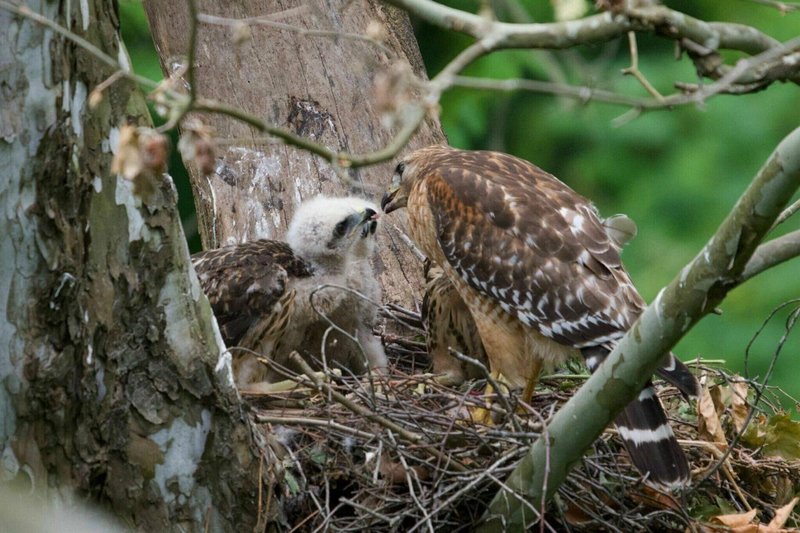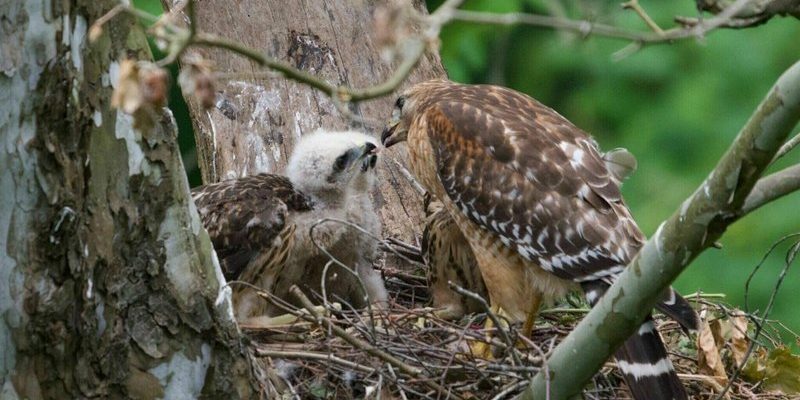
The Nesting Process of Hawks
Hawks are picky when it comes to choosing a nesting site. They prefer locations that offer a great view and protection, usually picking tall trees or ledges high above the ground. This helps keep their nests safe from potential threats. It’s like picking the best seat in a restaurant where you can see everything but still feel secure!
Once they find the perfect spot, it’s time to get to work. Hawks gather materials to build their nests, often using sticks, grass, and sometimes even trash. Yes, they can be a bit resourceful! The female typically does most of the nest building, while the male helps out by bringing her materials. You might be surprised to know that some hawks will return to the same nest year after year, adding more to it as time goes on. It’s like a family home that gets more comfortable with each generation.
Hawks usually lay between one to five eggs, depending on the species. The eggs are often white with speckles and look quite adorable. Once the female lays her eggs, she’ll start incubating them. This usually lasts about 30 to 35 days, during which the male provides food for her. It’s a team effort, and both parents are involved in protecting and feeding their little ones.
The Incubation and Hatching Period
During the incubation period, the female hawk spends a lot of time sitting on her eggs to keep them warm. This is crucial because, just like baking a cake, the right temperature is key to a successful outcome. If the eggs get too cold or too hot, it can affect the chicks’ development.
While the female is busy keeping the eggs warm, the male hawk takes on the role of the hunter. He soars through the skies, searching for food to bring back to her. This often means catching small animals like rodents or birds. It’s a tough job, but he’s got to make sure his partner stays well-fed, so the eggs hatch successfully.
After about a month, if all goes well, the eggs start to crack! You might see little beaks poking through the shells, which is the beginning of a new life. The chicks, or eyases as they’re called, are born blind and covered in downy feathers. They rely entirely on their parents for warmth and food at this stage. Talk about a vulnerable start!
The Early Life of Hawk Chicks
Once the hawk chicks hatch, their world begins to expand, though they still depend on their parents for everything. In the first few weeks, the chicks will stay in the nest, which is often quite crowded. You can imagine siblings jostling for space—it’s a wild scene! During this time, both parents take turns feeding the chicks with freshly caught prey, which helps them grow fast.
As the days pass, the chicks begin to develop feathers and their eyesight improves. By three to four weeks of age, they start to look more like the majestic birds they’ll become. It’s amazing how quickly they grow! Around this time, they may even start practicing their wing exercises. Just picture them flapping their little wings in excitement, readying themselves for the day they’ll take to the air.
Around six to seven weeks post-hatching, the chicks will venture out of the nest for the first time. This is a critical moment in their lives. They’ll try flapping their wings and may even take a few short flights. But don’t worry if they don’t get it right the first time; learning to fly can be tricky! Their parents will encourage them, showing them how to hunt and survive in the wild.
Parental Involvement and Chick Development
Hawk parenting is a full-time job, and both parents play a significant role in their chicks’ upbringing. After the chicks fledge (leave the nest), they’ll still rely on mom and dad for food and lessons in survival. This period is often referred to as the post-fledging stage. Picture it as an extended internship where the young hawks learn the ropes from their experienced parents.
During this time, they’ll continue to grow stronger and sharper in their hunting skills. The parents will bring food to their offspring, teaching them how to identify prey. You might see them swooping down to demonstrate before letting the chicks give it a try. It’s a critical bonding experience that builds both physical strength and confidence in the young hawks.
After about three months, the young hawks are nearly ready to fend for themselves. By this point, they’ll have developed most of their adult feathers and hunting skills. They often stay close to the nest as they learn the ins and outs of their territory. However, as they get older, they start to feel the instinct to be independent.
Leaving the Nest: The Journey to Independence
The transition from dependent chicks to independent hawks is a significant milestone. After about two to four months, the young hawks are ready to take on the world. This is usually when they leave their parental territory in search of their own. Think of it as graduating from school and heading out into the real world!
But leaving home isn’t always a smooth process. Young hawks can face many challenges, including finding food and avoiding predators. They may struggle initially, which is part of the learning curve. It’s a tough world out there! Some young hawks will remain near their parents for a bit longer, watching and learning before they fully strike out on their own.
Once they establish their territory, they might even find a mate and nest of their own in the future, continuing the cycle of life. It’s a remarkable journey that starts from those vulnerable eggs to becoming magnificent birds of prey.
Hawk Nesting Patterns: Species Variation
Different species of hawks have their own unique nesting habits. For instance, the Red-tailed Hawk often builds its nest high in large trees, while the Cooper’s Hawk may choose a more sheltered spot, often in deciduous trees. This variation is essential for helping different species adapt to their environments.
Some hawk species, like the Osprey, will even use the same nest year after year, adding more materials as needed. Others, like the Sharp-shinned Hawk, are more nomadic and may change nesting sites frequently depending on food availability. This flexibility helps them survive in varying conditions.
Understanding these differences can help bird watchers and nature enthusiasts appreciate the incredible adaptability of hawks. The way they construct their nests and raise their young is a testament to the brilliance of nature.
Hawk nesting habits and their lifecycle are not just intriguing—they’re essential to the survival of these incredible birds. From the careful selection of nesting sites to the challenging journey of raising chicks, hawks demonstrate the beauty of nature’s design. It’s a cycle filled with teamwork, resilience, and the instinct to nurture.
Next time you spot a hawk soaring through the sky or perched majestically on a branch, remember the incredible journey it has taken to get there. The intricate details of their nesting and the early life of chicks are reminders of the wonders of wildlife. By learning more about these magnificent creatures, we can foster a deeper respect and appreciation for the ecosystems we share—an essential step in conserving their future.

